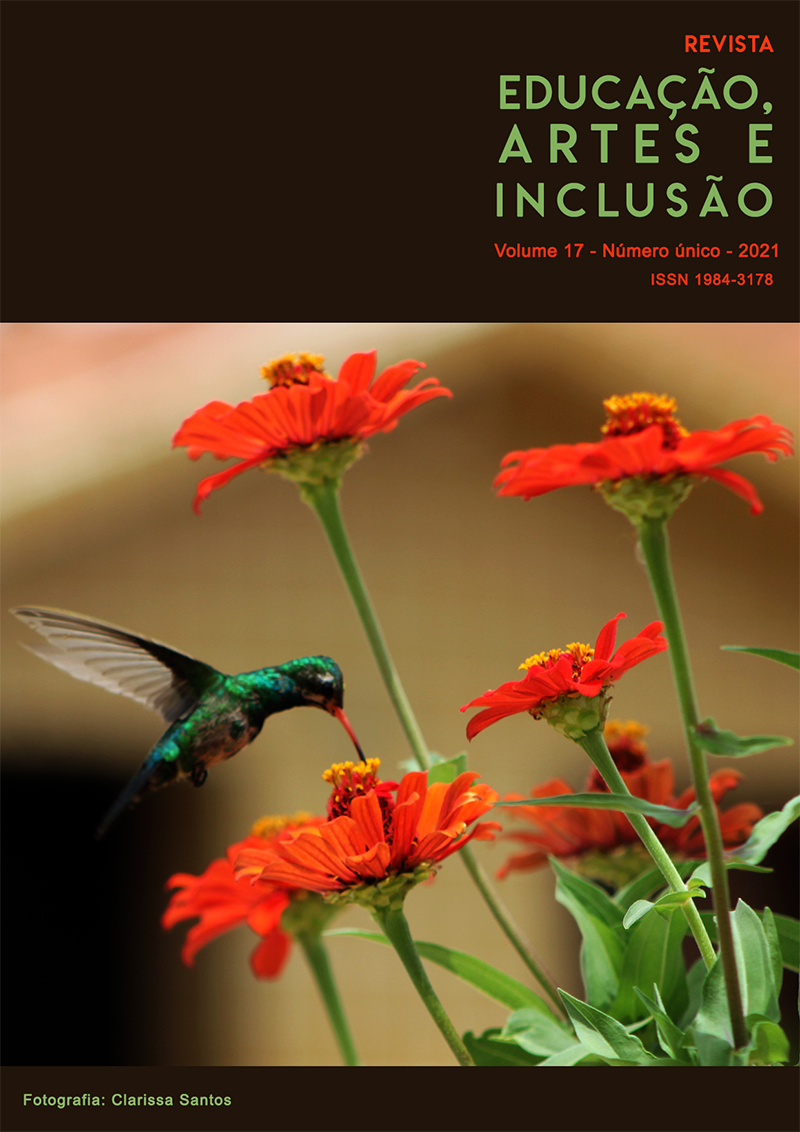Documentos de processos na docência em Artes Visuais no sertão do Seridó-RN
DOI:
https://doi.org/10.5965/19843178172021e0001Palavras-chave:
Artes visuais, estêncil, intervenção, ensino de ArteResumo
O presente artigo tem o propósito de discutir o ensino de arte praticado no sertão do Seridó potiguar, a partir de documentos de processos produzidos no exercício docente em artes visuais, durante a realização de um projeto de intervenção artística e cultural, com ênfase no estudo do estêncil, em uma escola pública estadual de Caicó-RN. Entendemos por documentos de processos os vestígios deixados/produzidos durante o processo criador (SALLES, 2009, p. 21), seja do artista ou do arte/educador. Este deixa, no seu exercício profissional, marcas do seu percurso criativo com os educandos. O “trabalho faz uma curadoria dos documentos, enquanto acompanha seus processos”, (PASSOS, et al, 2009), primando pelas produções coletivas do conhecimento, ao mesmo tempo em que segue as recentes orientações epistemológicas do ensino de arte, conforme percebemos em BARBOSA, 2005, 2009; IAVELBERG, 2003, 2017; MARTINS, 2009; FERRAZ & FUSARI, 2009, 1993. Os registros das práticas docentes em Arte são de grande importância para o desenvolvimento da criatividade, o aumento da percepção e a melhoria do fazer pedagógico nessa área do conhecimento.
Downloads
Referências
BANKSY. Guerra e spray. Trad. de Rogério Durst. Rio de Janeiro: Intrínseca, 2012.
BASBAUM, Ricardo. Além da pureza visual. Porto Alegre: Zouk, 2007.
BASBAUM, Ricardo. Amo os artistas-etc. In: Manual do artista-etc. Rio de Janeiro: Azougue, 2013.
BASTOS, Flávia Maria Cunha. Celebrando autorias: arte, comunidade e cotidiano em arte-educação. In. Visualidades. Revista do programa de mestrado em cultura visual. v. 3, nº 1 - FAV / UFG, 2015. Disponível em: https://www.revistas.ufg.br/VISUAL/article/view/17932 Acesso em 31/01/2018.
BASTOS, Flávia Maria Cunha. O perturbamento do familiar: Uma proposta teórica para a Arte/Educação baseada na comunidade. In: BARBOSA, A. M. Arte educação contemporânea: consonâncias internacionais. São Paulo: Cortez, 2005. p. 227-244.
BARBOSA, Ana Mae. A imagem no ensino da arte: anos 1980 e novos tempos. São Paulo, Perspectiva, 2009.
BARBOSA, Ana Mae. Arte/Educação contemporânea: consonâncias internacionais. São Paulo: Cortez, 2005.
BARBOSA, Ana Mae; COUTINHO, Rejane Galvão. Ensino de arte no Brasil: aspectos históricos e metodológicos. Rede São Paulo de Formação Docente, São Paulo, 2011.
BRASIL, Secretaria de Educação Fundamental. Parâmetros curriculares nacionais: arte. Brasília: MEC/SEF, 1998.
CANCLINI, Néstor García. Culturas híbridas: estratégias para entrar e sair da modernidade. São Paulo: Ed. Universidade de São Paulo, 2006.
CLARK, Lygia. Nós somos os propositores. Livro-obra, 1964.
FERRAZ, Maria Heloisa Corrêa de Toleto. Arte na educação escolar. Maria Heloisa Corrêa de Toledo Ferraz e Maria Felisminda de Rezende e Fusari. 3. ed. São Paulo: Cortez, 2009.
FERRAZ, Maria Heloisa Corrêa de Toleto. Metodologia do ensino de arte. São Paulo: Cortez, 1993.
FREIRE, Paulo. Pedagogia da autonomia: saberes necessários à prática educativa. São Paulo: Paz e Terra, 1996.
FREIRE, Paulo. Pedagogia do oprimido. Rio de Janeiro: Paz e Terra, 2014.
HALL, Stuart. A identidade cultural na pós-modernidade. Rio de Janeiro: DP&A, 2006.
IAVELBERG, Rosa. Para gostar de aprender arte: sala de aula e formação de professores. Porto Alegre: ArtMed, 2003.
IAVELBERG, Rosa. Arte/Educação Modernista e Pós-Modernista: fluxos na sala de aula. 1. ed. Porto Alegre: Editora Penso, 2017.
LUCKESI, Cipriano Carlos. O que é mesmo o ato de avaliar a aprendizagem? Pátio. Porto Alegre: ARTMED. Ano 3, n. 12 fev./abr. 2000.
MARTINS, Mirian Celeste. et al. Teoria e prática do ensino de arte: a língua do mundo. São Paulo: FTD, 2009.
PASSOS, Eduardo, KASTRUP, Virginia, ESCÓSSIA, Liliana (org.). Pistas do método da cartografia: pesquisa-intervenção e produção de subjetividade. Porto Alegre: Sulina, 2009.
ROMÃO, José E. Compromissos do educador de jovens e adultos. In: Educação de jovens e adultos: teoria, prática e proposta. Moacir Gadotti e José E. Romão (Org.). São Paulo: Cortez: Instituto Paulo Freire, 2001.
SALLES, Cecília Almeida. Gesto inacabado: processo de criação artística. São Paulo: FAPESP: Annablueme, 2009.
SANTOS, Jailson Valentim dos. Sertão de luz, pedra e resistência: caminhando por territórios docentes em artes visuais no Seridó-RN. Dissertação (Mestrado) - UFPB-UFPE. João Pessoa-PB, 2016.
Downloads
Publicado
Como Citar
Edição
Seção
Licença
Copyright (c) 2021 Jailson Valentim dos Santos

Este trabalho está licenciado sob uma licença Creative Commons Attribution-NonCommercial 4.0 International License.
A Revista Educação Artes e Inclusão é um periódico que segue a Política de Acesso Livre. Os artigos publicados pela revista são de uso gratuito, destinados a aplicações educacionais e não comerciais. Os artigos cujos autores são identificados representam a expressão do ponto de vista de seus autores e não a posição oficial da Revista Educação, Artes e Inclusão [REAI].
Autores que publicam nesta revista concordam com os seguintes termos:
(a) Autores mantém os direitos autorais e concedem à revista o direito de primeira publicação, com o trabalho simultaneamente licenciado sob a Licença Creative Commons Attribution que permite o compartilhamento do trabalho com reconhecimento da autoria e publicação inicial nesta revista.
(b) Autores têm autorização para assumir contratos adicionais separadamente, para distribuição não-exclusiva da versão do trabalho publicada nesta revista (ex.: publicar em repositório institucional ou como capítulo de livro), com reconhecimento de autoria e publicação inicial nesta revista.
(c) Esta revista proporciona acesso público a todo o seu conteúdo, uma vez que isso permite uma maior visibilidade e alcance dos artigos e resenhas publicados. Para maiores informações sobre esta abordagem, visite Public Knowledge Project.
Esta revista está licenciada com uma Licença Creative Commons Atribuição-NãoComercial 4.0 Internacional. Esta licença permite que outros remixem, adaptem e criem a partir do seu trabalho para fins não comerciais, e embora os novos trabalhos tenham de lhe atribuir o devido crédito e não possam ser usados para fins comerciais, os usuários não têm de licenciar esses trabalhos derivados sob os mesmos termos.





